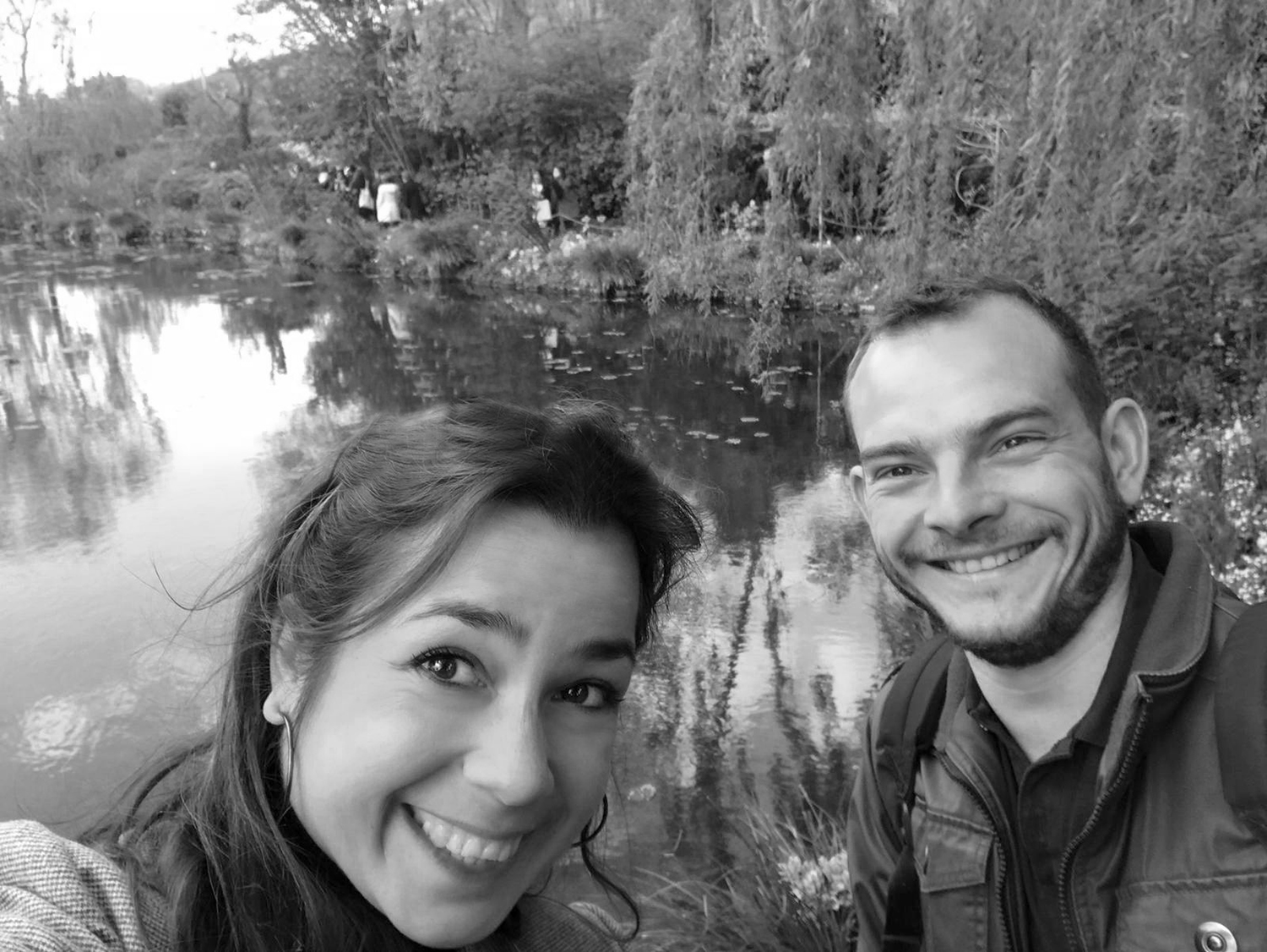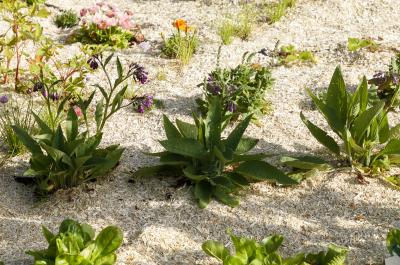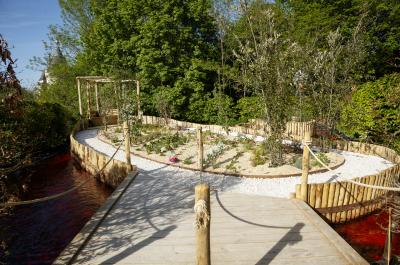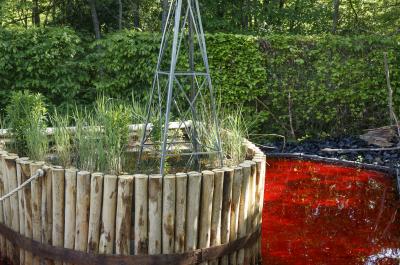04. Une (presque) île vertueuse
Neo chinampas
Awarded on the 21st of June 2023 by a jury of professionals renowned in the world of garden art

Resilience is a positive action that combines resistance and renewal. This garden also redefines a field of possibilities so as to take advantage of what nature has to offer us. It is inspired by the wisdom of the Chinampas, artificial Mexican islands set afloat on Lake Texcoco in the 14th century. Held up by wooden stakes planted beneath the water’s surface, they were composed of fertile interwoven reeds mixed with mud from the lake and aquatic plants. While continuing this agricultural tradition, the Neo Chinampas garden is also an innovative response to the three great crises we are facing today with regard to climate, ecology and food. It floats like hope itself on water reddened by bricks and iron oxide, symbolic of our many excesses, pollution and blood.
This modern Eden sets up two islands of freshness to counter the climate crisis, with the help of the trees planted on them and a pergola alive with climbing plants. It acts as a biodiversity reservoir in the face of the ecological crisis. Unlike Noah’s Ark, this “reservoir of living things” is not fleeing the apocalypse but adapting to it, establishing a dialogue with nature and coalescing her riches: filtered water to drink, fruit and vegetables for sustenance, loam to fertilise, insects to gather pollen, sun to keep warm and grow, and wind to make the reeds dance and turn the vanes of its wind pump. And finally, it responds to the food crisis by providing an edible garden. With arable land becoming scarce, permaculture and creation of artificial fertile soils are a solution. On board this virtuous (almost) island, everything is designed to ensure circular food self-sufficiency.
DESIGNERS

Guillaume Collaudin and Louise Quintana met in 2014 at Château de Villandry, where they both worked. Gardener and landscaper, they are two sides of the same coin. Complementary in their approach to landscape, they are both activists on behalf of all living things, which they see as of fundamental importance to our future.
Louise Quintana is a landscape designer. With a passion for living things and the arts, she opted for the landscaper’s profession as a matter of course, as it combined her interest in biodiversity with her design skills. After obtaining an Advanced Technician’s Certificate (BTS) in spatial design at Nantes’ School of Design, she enrolled at the National Higher School of Landscape (ENSP) in Versailles. Her course there included apprenticeships at the Bureau d’Études de Gally, Horticulture et Jardins (Pierre Alexandre Risser) and Atelier Silva Landscaping. Following her graduation, the knowledge she had acquired on the creative process and project management, along with the skills she had developed in design of high-end gardens and layout of public spaces, enabled her to join the Urban Act Architecture et Ecologie Territoriale agency. As a member of this multidisciplinary firm, she worked on regional projects and eco-neighbourhoods in which questions of sustainability (restoration of ground permeability, stormwater management, creation of cool islands, recycling of materials, differentiated management, indigenous plant palettes requiring little watering, etc.) and the challenges involved in new technologies (connected smart solar lighting and watering systems, biosourced composite materials, satellite surveillance of our ecosystems, etc.) were all subjects that nourished and sized her projects. It was not long before she launched her freelance activities, with projects that led her to work on very varied scales, from extensive landscapes in collaboration with local authorities (Département of Loire Atlantique and the Conservatoire du Littoral) to creation of gardens for private individuals. Born into a Franco-Peruvian family and having travelled a great deal since she was a small child, Louise Quintana was made aware of the diversity of cultures and landscapes when she was very young. These days, this enables her to understand the role that human beings play in their territory, incorporating the diversity of their social and cultural practices. This mosaic of places, stories and knowhow is the ground soil of her work. Revealing the genus loci, drawing on local living forces and blending into the original landscape are the watchwords in her vision of landscaping projects. Humanist projects rooted in their sites and avoiding any trivialisation or standardisation of our landscapes at all costs.
Guillaume Collaudin is a head gardener. As a teenager, he had a passion for working with living things and nature, and started specialising in horticulture in his 3rd year of lower secondary education. In 2008, he joined the French organisation of craftspeople and artisans, the Compagnons du Devoir and started out on his Tour of France. Those 7 years of journeying to all four corners of the Republic were to take him as far as New Caledonia, where he broadened his horticultural and botanical knowledge. The diversity of soils, climates and plant palettes form an integral part of his expertise. His experiences in such prestigious estates as Château de Villandry, the King’s Vegetable Garden at Versailles and Domaine de Coubertin enabled him to acquire the knowhow and rigorous techniques required in gardened forms of fruit-growing and deepen his overall knowledge of the plant world. As a result, he has come to assist plant life, guiding it with respect while enhancing its performance, developing structures, planting and training young trees, and discovering rootstocks and their importance. He asserted his interest in vegetable gardens during his time at Villandry and Coubertin. He studies numerous varieties of edible flowers and rare heirloom vegetables and methods of growing them. The harvesting of seeds and the right combinations to create a cultivation plan and its rotation are part and parcel of his profession. Today, Guillaume Collaudin is head gardener at Château de Valmer in Touraine, where he has come fully into his own managing and maintaining 5 hectares of a remarkable “Italian Renaissance”-style garden. He makes use of all the gardening practices he has acquired over the course of his career and now shares them in his turn, training the next generation of gardeners.


